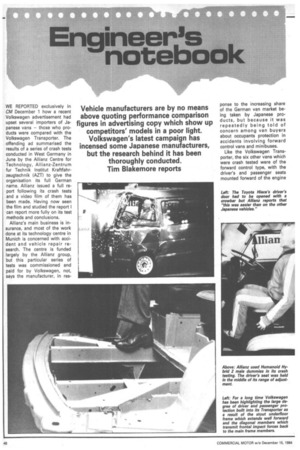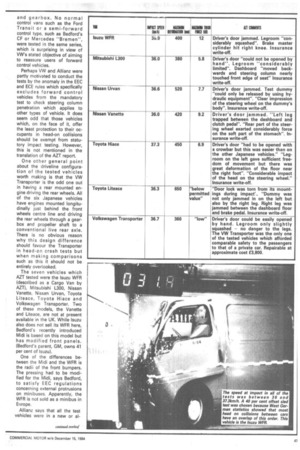WE REPORTED exclusively in CM December 1 how a recent
Page 48

Page 49

Page 50

If you've noticed an error in this article please click here to report it so we can fix it.
Volkswagen advertisement had upset several importers of Japanese vans — those who products were compared with the Volkswagen Transporter. The offending ad summarised the results of a series of crash tests conducted in West Germany in June by the Allianz Centre for Technology, Allianz-Zentrum fur Technik Institut Kraftfahrzeugtechnik (AZ-1) to give the organisation its full German name. Allianz issued a full report following its crash tests and a video film of them has been made. Having now seen the film and studied the report I can report more fully on its test methods and conclusions.
Allianz's main business is insurance, and most of the work done at its technology centre in Munich is concerned with accident and vehicle repair research. The centre is funded largely by the Allianz group, but this particular series of tests was commissioned and paid for by Volkswagen, not, says the manufacturer, in res
ponse to the increasing share of the German van market being taken by Japanese products, but because it was repeatedly being told of concern among van buyers about occupants protection in accidents involving forward control vans and minibuses.
Like the Volkswagen Transporter, the six other vans which were crash tested were of the forward control type, with the driver's and passenger seats mounted forward of the engine and gearbox. No normal control vans such as the Ford Transit or a semi-forward control type, such as Bedford's CF or Mercedes "Bremen", were tested in the same series, which is surprising in view of VW's stated objective of aiming to reassure users of forward control vehicles.
Perhaps VW and Allianz were partly motivated to conduct the tests by the anomaly in the EEC and ECE rules which specifically excludes forward control vehicles from the mandatory test to check steering column penetration which applies to other types of vehicle. It does seem odd that those vehicles which, on the face of it, offer the least protection to their occupants in head-on collisions should be exempt from statutory impact testing. However, this is not mentioned in the translation of the AZT report.
One other general point about the driveline configuration of the tested vehicles worth making is that the VW Transporter is the odd one out in having a rear mounted engine driving the rear wheels. All of the six Japanese vehicles have engines mounted longitudinally just behind the front wheels centre line and driving the rear wheels through a gearbox and propeller shaft to a conventional live rear axle. There is no obvious reason why this design difference should favour the Transporter in head-on crash tests but when making comparisons such as this it should not be entirely overlooked.
The seven vehicles which AZT tested were the Isuzu WFR (described as a Cargo Van by AZT), Mitsubishi L300, Nissan Vanette, Nissan Urvan, Toyota Liteace, Toyota Hiace and Volkswagen Transporter. Two of these models, the Vanette and Liteace, are not at present available in the UK. While Isuzu also does not sell its WFR here, Bedford's recently introduced Midi is based on this model but has modified front panels. (Bedford's parent, GM, owns 41 per cent of Isuzu).
One of the differences between the Midi and the WFR is the radii of the front bumpers. The pressing had to be modified for the Midi, says Bedford, to satisfy EEC regulations concerning external protrusions on minibuses. Apparently, the WFR is not sold as a minibus in Ei I rope.
Allianz says that all the test vehicles were in a new or al most new condition, so that corrosion or poor maintenance should not affect the results. The sled test rig used by AZT is claimed to be "one of the most modern and precise devices" of its kind. Indeed, AZT and the UK's Motor Insurance Repair Research Centre at Thatcham are reckoned to be the only two insurance organisations anywhere to own such equipment.
The West German engineers chose to use a 40 per cent offset test as a basis for compairson of the seven vans. The vehicles were propelled into a concrete block which overlapped the driver's side of the vehicle and covered 40 per cent of its frontal area. This is a recognised impact test procedure though some engineers argue that a test using a barrier angled at 30 deg is better than one with a block set at right angles to the vehicle's path because the variability of the results due to any slight misalignment of the vehicle is reduced.
Allianz's statistics from car accidents in West Germany showed that in 50 per cent of head-on collisions there was a driver's side overlap of 30 to 50 per cent. Though the organisation has no similar statistics for vans it was felt nevertheless that a 40 per cent offset test for this type of vehicle was equally valid.
The speed at which the seven vans were propelled into the barrier was between 35 and 38km/h (21.8 and 23.6mph). A more widely used speed for impact tests is 50km/h. AZT's report does not make it clear exactly why the lower speed was chosen, except to say that the decision was taken following "a preliminary experiment" and that the test impact was meant to correspond with a head-on collision of two vehicles of similar type, both travelling at a speed below 50km/h (31mph).
All of the tested vehicles were unladen except for the dummy — a Humanoid Hybrid 2 male type, 1.75m tall, which was secured in the driver's seat by a standard three-point safety belt, On each van the driver's seat was put in the middle of its range of adjustment. The dummy was wired so that accelerations of the head and chest and the forces in both thighs could be measured. The acceleration of the vehicle was measured by two sensors between the axles. A high-speed camera, capable of taking .500 frames a second, was mounted inside each van and two others, one at one side and one above the van, took photographs of each test from outside.
In its report AZT refers to two internationally accepted standards for measuring the risk of injury to chest and brain in crash tests, These are the HIC (head injury criterion) which is used as a measure for brain injury and SI (severity index). This is less widely accepted but is used to measure the risk of chest injury.
According to AZT's report all the tested vans performed well in this area. HIC and SI values for all vehicles were below 500, and 1,000 is accepted as being the figure which should not be exceeded, while some argue it may be as high as 1,500. AZT attributes the low HIC and SI values measured during its testing to the use of safety belts.
The report also refers to a recently revised American safety standard for maximum thigh forces in crash tests and to a draft EEC standard which calls for a lower limit, The Americans say maximum thigh force should not exceed 10kN (1.004 ton), while the EEC draft calls for forces applied for more than three milliseconds not to exceed 7.7kN (0.773 ton).
The results table on page 47 shows the maximum thigh forces that were measured by AZT in each van test as well as the maximum deformation of the cab. It is in this area of deformation of the lower part of the cab that Allianz is most critical of the Japanese vans and it is here that Volkswagen is making most capital from the test results, The rights and wrongs of an organisation like Allianz publishing results of its crash tests and of their use in advertising is a subject which is sure to continue to cause lively debate. The UK's Motor Insurance Repair Research Centre is adamant that it would not publish results of any similar tests conducted at Thatcham, but would inform the manufacturer of any vehicle on which it found a problem.
No counter claims based on other crash tests have yet been made by the Japanese manufacturers involved, but these must remain a possibility.
For a long time Volkswagen has been emphasing the strength of its Transporter models in head-on collisions, so it is hardly surprising that it was prepared to make the most of these tests conducted by a well respected, independent organisation in its publicity material. And these results certainly are interesting.
But it would be a great shame, since it would surely devalue the work, if vehicle safety research became more widely used in advertising battles,












































































